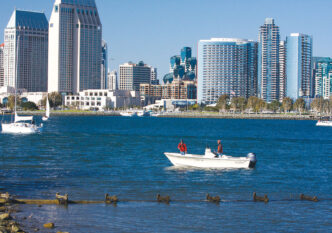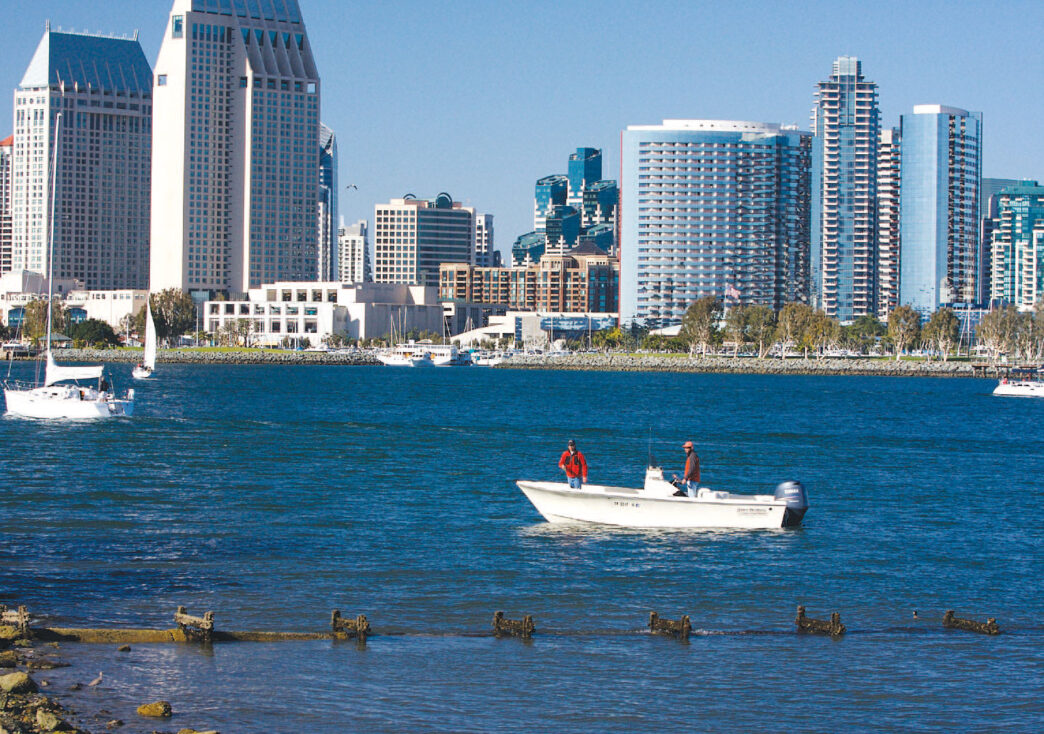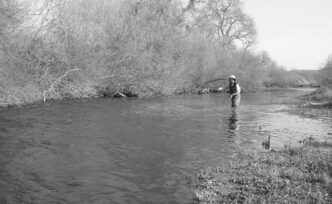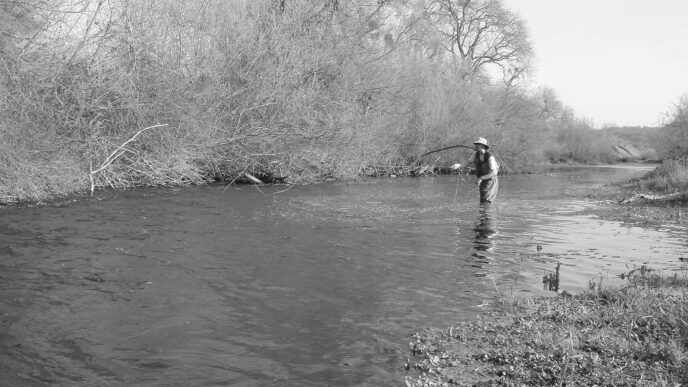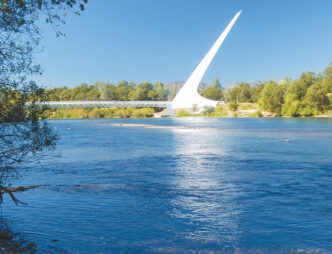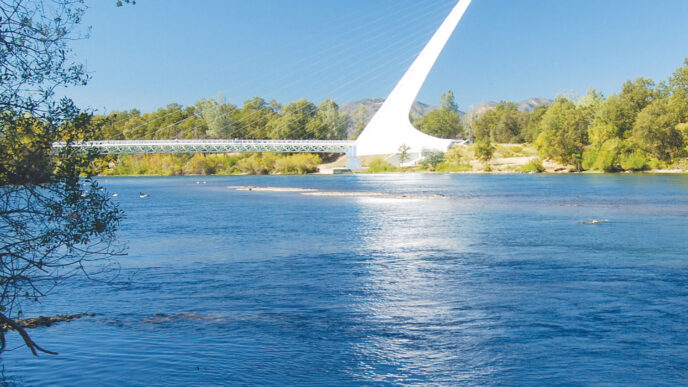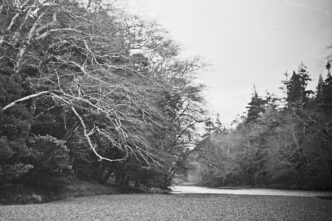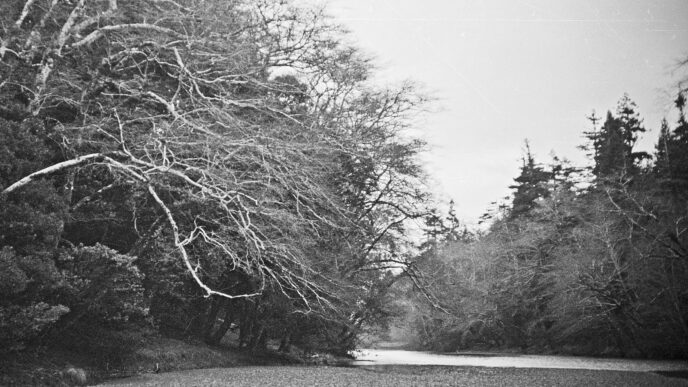We left the dock before the sun peeked above the horizon. The black surface of the water, smooth as glass, reflected the lights of the city as if a mirror, and my buddy Tad and I sipped our coffee, listening to the low growl of the boat’s engine and wondering what we would find this morning. We were preparing to fish San Diego Bay with our guide, Captain Peter Piconi, a longtime friend.
After ten minutes, Peter backed off the throttle and we glided slowly into our fishing spot near a large rock jetty on the northern side of the bay. Tad grabbed his 8-weight and jumped into position on the bow of the boat. Just then, I heard the splash of a feeding fish off in the distance, but could not make out what it was through the darkness. “Nice fish!” Peter whispered. “Probably a bonito.”
On Tad’s first cast, the line came tight with a jolting grab and the drag screamed as the fish lunged for freedom. The bonito’s first run was the longest, and after several shorter runs, gradually slowing with exhaustion, it finally came to the boat, where Captain Peter was waiting to net and release the beautiful four-pound fish.
The bonito blitz lasted until the sun hit the water that morning, which is typical. These fish prefer low-light conditions. Fortunately, Tad, Peter, and I had managed to land several bonito. That kind of action is hard to beat while fishing 7-weight and 8-weight rods on San Diego Bay.
The Character of San Diego Bay
San Diego Bay, a natural harbor and deepwater port, is considered to be one of the best natural harbors on the West Coast. It is home port to several aircraft carriers of the United States Pacific Fleet and the only remaining major naval base still in operation in the entire state of California.
San Diego is visited and enjoyed by thousands of people each year. Sailing, jet skiing, wakeboarding, and of course, fishing are all popular on the bay. The harbor possesses good fishing year-round and offers something for every level of fly fisher. Rocky shores, sandy beaches, bridge pilings, and grassy flats abound, as do facilities for launching small boats, and boat rentals are available to get you out closer to the fish. With all the water activities that the bay has to offer and all the boating commotion going on, San Diego Bay is considered by knowledgeable anglers as the most productive bay for fishing in our state. The bay is home to a variety of resident fish, including spotted bay bass, calico bass, sand bass, yellowfin croakers, spotfin croakers, halibut, shortfin corvinas, and bonefish, to name a few. And the bay entertains a range of migratory species — bonitos, mackerel, barracudas, white seabass, and more. Numerous waterways, rock formations, deep troughs, and abundant mud flats hold a plentiful amount of aquatic life that adds up to a great mix of ingredients for both residential and migrating fish.
The Fishing
Locating fish and bait in this large bay is priority number one for any angler. Although fish are present throughout the bay, targeting specific areas can lead to greater success. That’s one reason why the most productive way to fish San Diego Bay is from a boat. “This is a large body of water, and having the ability to maneuver in and out of all the nooks and crannies this fishery has to offer is priceless,” Piconi points out.
Roving fish, such as yellowtail, bonitos, mackerel, barracudas, and white seabass, make their journey through San Diego Bay throughout the year. These traveling fish tend to be found in many of the deep channels and passageways as they pursue baitfish that get sucked into and out of the bay with the moving tides. Consequently, most days on the water, Piconi focuses a portion of his fishing along the channel drop-offs.
The channels are highways for the large ships that travel in and out of the harbor. In them, as small baitfish swim helplessly along with the moving tides, larger fish hold in ambush hot spots, usually at drop-offs and cuts where shallow water descends into deeper water, waiting for an easy meal. Channel markers situated throughout the bay help boaters locate the deeper water, and anglers can use them that way, too. During the day, when the sun is bright overhead, you can spot the drop-offs by the color change in the water: light-colored water changes to a deep green. Captain Piconi sets up his boat to drift along the drop-offs and uses a trolling motor to stabilize his boat in the prime position.
Piconi feels that the most productive way to fish San Diego Bay is to use an intermediate line. This line will sink between one and two inches per second, and it provides better control for fishing the depth at which he likes to fish than a floating or full sinking line. Intermediate lines are especially helpful during the fall and winter, when water temperatures drop and fish are not feeding as aggressively. Because an intermediate line stays in the strike zone longer, it allows the angler to fish a fly using a very slow retrieve that will entice finicky fish.
In addition to channel drop-offs, other areas that Captain Piconi often fishes include around docks, piers, and rock outcroppings. Calico bass and spotted bay bass, much like their freshwater cousins, largemouth bass, love to hunt under the cover of wharfs and such. Pinpoint casts placed very near these structures with small baitfish flies can produce jolting strikes that seem as if they’ll knock your watch off your wrist.
During the fall and winter, San Diego Bay stays warmer than the Pacific Ocean outside, and that brings bonitos and mackerel, members of the tuna family, into the bay. These fish can be found throughout the bay, including in small marinas and coves, aggressively feeding on anchovies, sardines, and other baitfish. They travel in schools and voraciously attack bait balls in blitzes. The blitzes can be quite a scene, not only for the fly fisher, but also for anyone out for a walk or a jog.
The shallow southern end of the bay holds schools of bonefish. It’s important to note that these are Pacific bonefish, but they do not make the blistering runs that their South Pacific relatives make, because over the years, they have evolved and have survived simply by being faster than any other fish species in San Diego Bay — and that isn’t all that fast. In addition to bonefish, corbinas and yellowfin croakers spend the majority of the year near the Back Bay, where the water temperature stays warmer than in the rest of the harbor. As the tide rises from low to high, the shallow-water flats begin to flood, and these fish move in with the rising water to seek out tiny morsels in the sand. Under the right conditions, sight fishing is possible on these flats.
Fishing Afoot
Although a boat is an advantage for any angler on water as big as San Diego Bay, for the adventurous angler, fishing on foot can be very productive. During the winter months, San Diego Bay receives some of its largest tidal swings, and the lower tides, known as minus tides, allow the angler on foot to reach otherwise submerged trenches and troughs, making possible shots at areas not easily fishable during other seasons.
Rock hopping on the many jetties and rock walls along Harbor Island and Shelter Island can be very rewarding. Large sand bass, bay bass, and calico bass love to hang around the jetties year-round. It’s important to remember to bring a stripping basket when fishing off the jetties. Without a basket, fly lines will get sucked between and around the rocks. It’s a nightmare waiting to happen.
When fishing on foot in the bay, you will need waders from time to time. Waders allow you to wade deeper and to reach the hot spots, especially on higher tides. If you choose not to wear waders, I recommend a pair of knee-high waterproof boots. At a minimum, the boots allow you to wade into the water for at least a few yards, but most of all, they keep the mud and muck off you.
When fishing afoot, I carry a fanny pack or backpack that holds fly boxes, extra leaders, tippet material, a hook sharpener, hemostats, pliers for pinching barbs, camera equipment, extra sunglasses, and a rain jacket. A hat and polarized glasses are a must for spotting fish in the shallows and for protecting your eyes from errant casts.
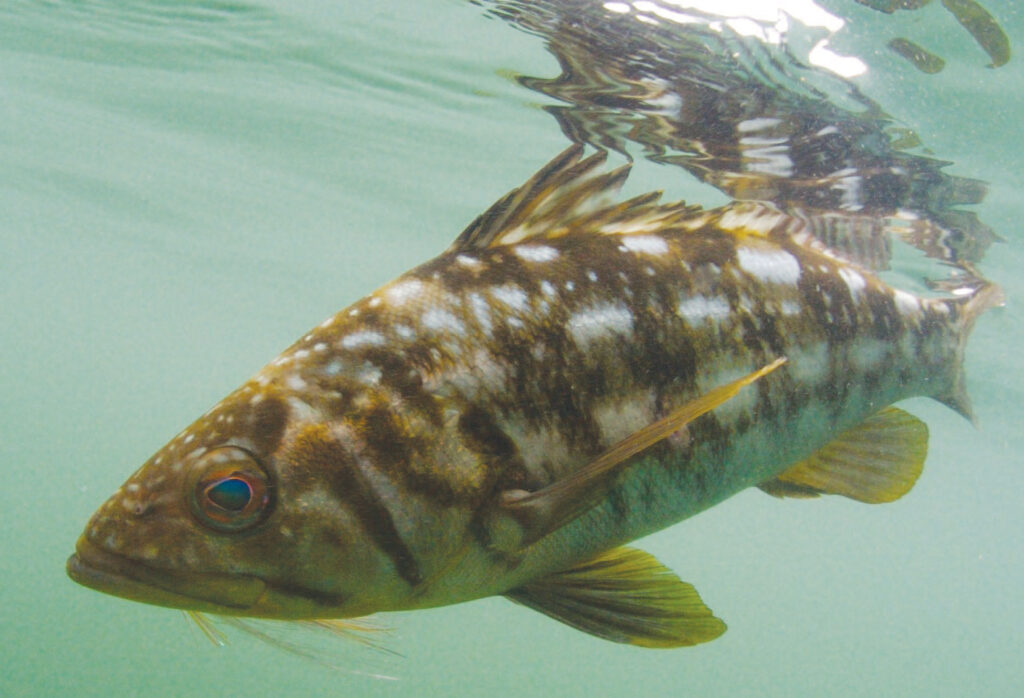
Gear for San Diego Bay
As far as rods go, I would recommend a 6-weight and an 8-weight. A 6-weight is a blast to use in the mornings, when there is little or no wind. However, an 8-weight is much easier to throw when the wind picks up. These two outfits cover most fishing situations you might run into.
I rig both rods with an intermediate line, but I carry extra spools with fast-sinking shooting heads, in case the fish are holding really deep. Also, in my younger days, when I ventured out onto the jetties, often I would throw fast-sinking shooting heads. Jetties equal deep water, so the heavier fly lines are necessary for getting the flies down to the strike zone. Reels will take a beating from the salt, so they should be anodized, and you should rinse them with fresh water after every use.
Because the migratory fish are following and feeding on small baitfish, I carry a supply of patterns that imitate those smaller fish — Deceivers, Clousers, Gummy Minnows, ALFs, Sea Habits, Glass Minnows, and Puglesi patterns, to name a few — in sizes 2 through 6. Off the jetties, I’ve tended to go a little bigger on the hook sizes — 1/0 and 2/0.
Bonefish and redfish flies work great when fishing the flats or along cuts and troughs. Any type of pattern that’s designed to imitate crabs or shrimp will get the attention of the bonefish, corbinas, and croakers that roam the bay.
Leaders should be a minimum of 8 or 9 feet long, including your tippet. I prefer a leader tapered down to 12-pound breaking strength, and I always use fluorocarbon tippets because of the material’s abrasion resistance and low visibility. When throwing surface bugs, a leader of 8 or 9 feet is still fine, but make sure you add a 30pound or 40-pound bite tippet, because short-fin corvinas have a couple of vampire-like fangs protruding from their upper jaws that can wreak havoc with most leaders.
Top-Water Action
The fall and winter seasons in San Diego bring wind and sometimes rain. Although I consider it cold at this time of year, we in Southern California have it pretty good compared with the rest of the country. And some of the nastiest, windiest, and rainiest days, believe it or not, produce some of the best top-water action. When it rains, all the runoff washes into San Diego Bay. The runoff consists of God knows what, but it excites the small baitfish and gives them plenty of things on which to feed, and where there are baitfish, there are larger, predatory fish. They use backwater coves, rock walls, and small marinas to corral and ambush their prey.
When throwing surface bugs, I’ve had the best results using flies that make a lot of disturbance on the surface. That usually means bigger flies. Crease Flies, Pole Dancers, and a number of Rainy’s surface patterns work for me — the bigger the better. You need enough rod to be able to turn those flies over, even into a stiff wind. You might consider a 9-weight or 10-weight when targeting fish on the surface.
A Winter Wonderland
One of the most impressive features of the San Diego Bay is that it is a year-round fishery. When the rest of the country is holed up inside and tying flies, we in Southern California have fishing opportunities to keep our angling addiction well-fed. And the beauty of fishing San Diego Bay is that you can disguise your fishing as a family vacation, complete with visits to the world-famous San Diego Zoo, Sea World, Legoland, and the local beaches. Moreover, while the rest of the family is enjoying breakfast and getting ready to start their day, you can be finishing a morning’s fishing on the big bay. What a great idea, wouldn’t you agree?
If You Go…
Several resorts, hotels, and the San Diego Convention Center are adjacent to the bay. Also, a few parks and nature preserves are found at various locations along the shoreline. Sightseeing boats and harbor cruises depart from the downtown area. Sportfishing boats and whale-watching tours depart from Shelter Island.
Harbor Island and Shelter Island in the northern part of the Bay were built up from former sandbars and are now home to restaurants, hotels, marinas, fishing tackle shops, and public parks. Shelter Island boasts the largest fleet of sportfishing vessels in the world.
There are accomplished guides on the bay who cater to fly fishers. I highly recommend booking a day with one or more of these experienced anglers to help jump start your knowledge of the San Diego Bay fishery.
- So Cal Fly Fishing Outfitters, Captain Peter Piconi: (619) 224-4000, http://www.socalflyfishing.com/Guide+Service/Trips.
- En La Mosca Adventures, Captain Bob Day: (858) 449-4071, http://www.enlamosca.com.
- On The Fly, Captain Dave Trimble and Captain John Hendrickson: (928) 380-4504, http://www.ontheflyfishingcharter.com.
- The Salty Doc, Captain John Grim: (858) 232-7225, http://saltydoc.net.
- Mike Sergeant Fly Fishing, Captain Mike Sergeant: (602) 617-9735, http://michaelsergeant.com.
Jeff Solis



